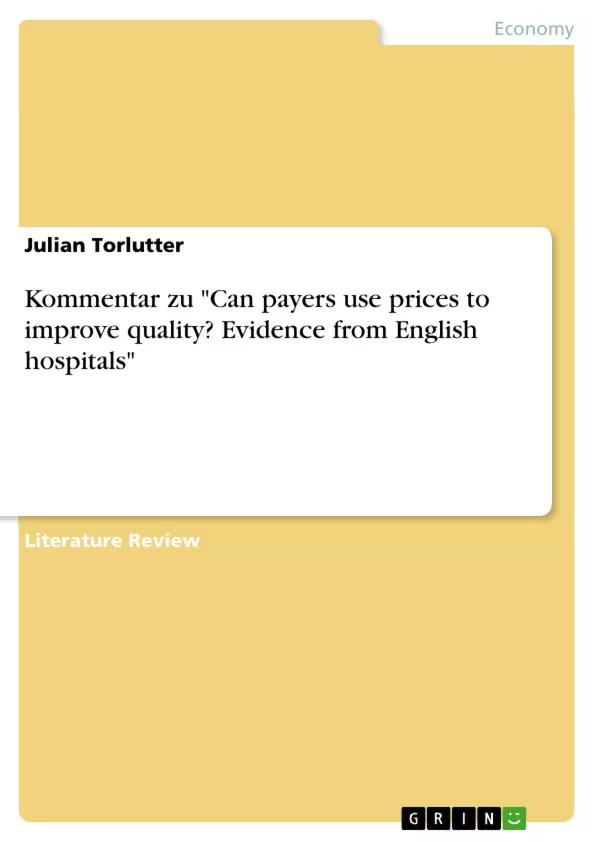The “Best Practice Tariff”-program (BPT) is one of many pay-for-performance models which have been introduced in the health system of the United Kingdom (UK). The first one was the "Quality and Outcome Framework" (QOF) followed by "Advancing Quality" (AQ), Commissioning for Quality and Innovation (CQUIN), "Non-Payment Policies" (NPP) until 2010, where the BPT has started. First, it was used in four indicators: cataract, gall bladder removal, stroke and fragility hip fracture. Now, the BPT includes 50 procedures in the UK. The payment of the service providers is based on the principles of the best treatment and therefore it does not depend on the average costs and can thus be higher or lower than the previously determined flat rate. The BPT can consequently be regarded as a punishment for hospitals that are not working compliant. The purpose of the BPT is to change treatments from inpatient cases to outpatient daycases, to reduce the number of appointments for patients and to increase the quality of the results. In the article by Allen et al. from 2016, the impact of the BPT on one of the four primary treatment cases, cholecystectomy, was investigated. Cholecystectomy is an operation in which the gallbladder is removed under general anesthesia, either laparoscopically or as an open surgery. Laparoscopic cholecystectomy is classified as an intervention in the UK, which can be performed as a daycase event. The aim of the BPT for cholecystectomy was to motivate the hospitals to carry out the procedure more frequently as a daycase event without losing quality. To investigate the effects of BPT, Allen et al. analyzed data from the Hospital Episodes Statistics from 1 December 2007 (before BPT) to 31 March 2011 (after introducing BPT). For this research, the cholecystectomy was compared with a control group consisting out of procedures from other medical fields (for example ear, nose, neck). After the evaluation Allen et al. came to the conclusion that a potential effect of the policy is visible. The concrete investigation results are discussed in Chapter 2.
Inhaltsverzeichnis (Table of Contents)
- Summary of the Journal Article
- Discussion of results
- Discussion of the relevance of the problem identified
- Is there anything to learn about for the German healthcare system?
- References
Zielsetzung und Themenschwerpunkte (Objectives and Key Themes)
The paper investigates the impact of the "Best Practice Tariff" (BPT) program on the quality and efficiency of cholecystectomy procedures in the United Kingdom. The BPT is a pay-for-performance model that incentivizes hospitals to provide best practice care, specifically encouraging a shift towards daycase procedures.
- Pay-for-performance models in healthcare
- Impact of BPT on cholecystectomy procedures
- Quality and efficiency improvements in healthcare
- Comparison of BPT to other pay-for-performance programs
- The role of transparency and evidence-based practice in healthcare
Zusammenfassung der Kapitel (Chapter Summaries)
- Summary of the Journal Article: This chapter introduces the "Best Practice Tariff" (BPT) program, a pay-for-performance model implemented in the UK healthcare system. It specifically focuses on the impact of BPT on cholecystectomy procedures, aiming to increase the frequency of daycase events while maintaining quality. The chapter outlines the study design and data used by Allen et al. to investigate the BPT's effects.
- Discussion of results: This chapter presents the findings of the study. The BPT is shown to have positive impacts, increasing the daycase proportion and planned daycase rates, while not leading to negative consequences on quality measures. It also discusses potential drawbacks, such as longer waiting times due to higher daycase rates.
- Discussion of the relevance of the problem identified: This chapter explores the broader context of pay-for-performance models in healthcare and their potential to improve quality and efficiency. It discusses the importance of quality and transparency in the healthcare sector and how pay-for-performance programs can contribute to these goals. It also briefly mentions similar initiatives in Germany.
Schlüsselwörter (Keywords)
The key focus topics of the text are pay-for-performance models, specifically the "Best Practice Tariff" (BPT) program, cholecystectomy procedures, healthcare quality and efficiency, daycase surgery, transparency in healthcare, and evidence-based practice. These terms highlight the core concepts and research interests of the paper, emphasizing the importance of alternative payment models in achieving a higher quality of care.
- Quote paper
- Julian Torlutter (Author), 2017, Kommentar zu "Can payers use prices to improve quality? Evidence from English hospitals", Munich, GRIN Verlag, https://www.grin.com/document/457988



